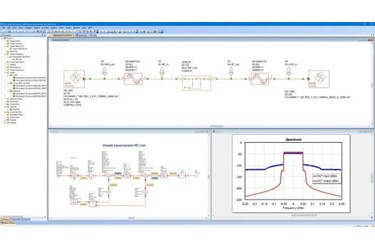R&S VSESIM-VSS combines EDA simulation with hardware testing

Rohde & Schwarz with Cadence have developed a solution aimed at simplifying the engineering process from RF design to implementation and enhancing accuracy by using realistic signals for both simulation and testing.
With new wireless and satellite technologies offering ever wider frequency ranges and involving increasingly demanding requirements, realistic signal simulation at the early stages in RF system design is more important than ever.
The R&S VSESIM-VSS signal creation and analysis tool supports all major standards such as 5G and the latest Wi-Fi evolutions. The solution combines signal generation, design simulation and signal analysis, building on the strengths of proven solutions from R&S and Cadence. As a result, developers and design engineers will b in receipt of an optimised tool that allows them to address design challenges earlier than before in the development process.
The VSESIM-VSS signal creation and analysis tool functions as an addition to the Cadence Visual System Simulator (VSS) software for system simulation and modeling, particularly for RF components and RF assemblies used in wireless communications and radar design.
The VSESIM-VSS has been designed to expand the capabilities of the VSS software by adding realistic signals to the workflow, increasing simulation accuracy and simplifying the design process.
It benefits from two established software tools from Rohde & Schwarz for testing operative circuits, modules and devices – the signal generation capabilities of the R&S WinIQSIM2 simulation software and the signal analysis capabilities of the R&S VSE vector signal explorer software. The VSESIM-VSS combines these functions and adds plug-ins for Cadence electronic design automation (EDA) tools.
The data sink plug-in from Rohde & Schwarz provides access to the signal at any point in the design process. The signal can be transferred to a vector signal generator and applied to available hardware, enabling system level analysis of hybrid hardware/simulated implementations.
An important feature is support of direct digital predistortion (DPD) techniques to verify the effects of linearization already in the simulation phase of power amplifier development.
Another significant benefit is that signal generation and analysis provided by the Rohde & Schwarz solution can also be used in other connected Cadence products such as the Cadence Microwave Office circuit design software or the Cadence Virtuoso RF Solution for radio-frequency integrated circuits (RFIC) and RF modules.
Commenting Christina Gessner, VP Spectrum & Network Analyzers, EMC and Antenna Test at Rohde & Schwarz said, “Connecting EDA design simulation and test and measurement helps our customers achieve first-pass design success and shorter times to market. Using realistic signals, deriving common figures of merit such as EVM and understanding linearization capabilities even before tape-out means a competitive advantage for our customers.”